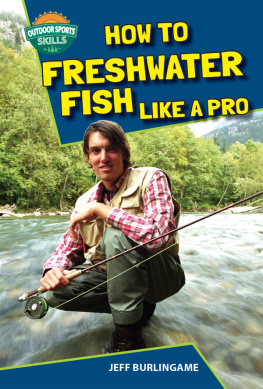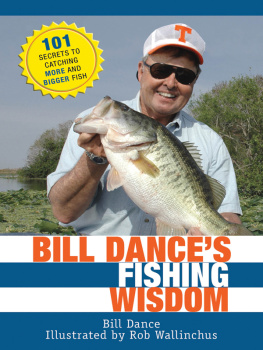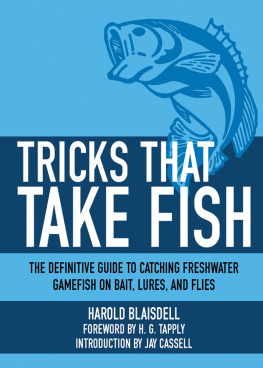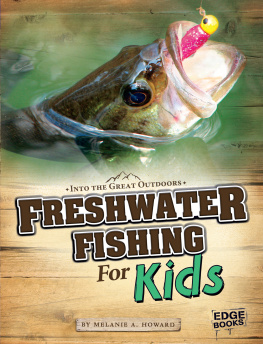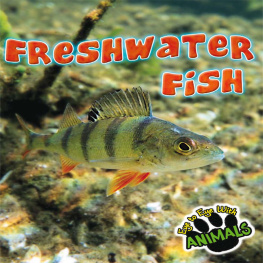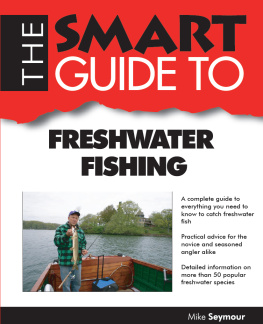The Thrill of the Catch
Would you like to experience the excitement of reeling in a trout after feeling a spirited tug on the line? Or perhaps you would enjoy the quiet solitude of wading in a stream, fishing rod in hand? Follow the advice of award-winning writer Jeff Burlingame as he explains freshwater fishing basics, and some of the finer points, too. Helpful hints include what fishing tackle you should buy, the best time of the day to fish, and the different ways to cast your line.

Your alarm clock goes off at four oclock in the morning and you wake to the sound of Dad rustling in the garage.
After taking a second to wipe the sleep from your eyes (and wonder if agreeing to get up so early on a Saturday was a good idea), your enthusiasm takes over and you spring from your bed. Sure, the lights are off in the rest of the houses in your neighborhood and most of your friends wont be awake for hours. But they dont love freshwater fishing as much as you do. You really cant pinpoint why.

Image Credit: Thinkstock: (Mike Watson Images/moodboard
If your fishing partner is standing with fishing pole in hand, you better hurry up and get ready!
Once you get dressed, you head out to join Dad in the garage. You can see that he obviously has been awake a little longer than you have; Dads almost ready to hit the road. So, after you help him load the last of the gear into the car, you hop in the passengers seat and that is what the two of you do. It will be daybreak in less than an hour, and you know from experience that daybreak is the best time of the day to catch fish at your favorite spot. It is a forty-five-minute car ride to get there.

Image Credit: Shutterstock.com: Lou Oates
Once everyone is dressed and the car is all packed up, its time to hit the road and get to a fishing spot.
Although it may feel like it the moment you arrive at the empty parking lot of your preferred lake, river, pond, or stream, you and your dad definitely are not the only people fishing today.

Image Credit: Shutterstock.com: Melissa King
The early bird catches the worm. Beat everyone to the water to start fishing to have the best chance to catch some fish!
Fishing is, in fact, one of the most popular sports in the United States. More people fish than jog, golf, play football, or ski. Tens of millions of Americans go fishing each year. Some fish so they can help feed their families. Others enjoy the challenge of the sport and spending quality time with family and friends in a relaxing outdoor environment. Whether or not you catch anything on your adventure (of course you sure hope you do!), freshwater fishing allows you to create priceless memories with a loved one and experience an activity that has been around tens of thousands of years.
In its simplest form, fishing is the art of catching fish. Exactly how, where, and when someone fishes can vary greatly. Artifacts have been found that show humans fished as far back as fifty thousand years ago. And many historians believe fishing was around long before that.

Image Credit: Shutterstock.com: Mr Patrick Morrow
In some parts of the world, a wooden spear is still the preferred fishing gear of choice.
During fishings earliest days, people mostly used wooden spears to catch fish. Fish were so plentiful that it was easy to catch fish that way. An angler would simply stand over (and typically in) a body of water, wait for a school of fish to swim by, and stab one of them with the end of the spear. The activity was not done simply for sport. Fish were the main source of food for many people during that time, and without it they may not have survived.
As humans evolved, so did the sport of fishing. HooksJ-shaped tools made of bone, wood, shells, stone, or, later, metalbecame popular some twenty thousand years ago. Hooks were also known as angles, and thus the sport of fishing also became known as angling.

Image Credit: Shutterstock.com: JonMilnes
Fishing began with a wooden spear, and over time, spear fishing has become a sport in itself.
Anglers tied whatever hook they used to some sort of line. In the earliest days, that line was made of whatever strong substance could be found, such as braided horse hair or silk. The hook and line were then attached to a rod made of bamboo or other type of lightweight wood. Bait was attached to the end of the hook and the bait and hook were tossed into the water to lure the fish to bite. When the fish took the bait, it was also snared by the hook. The anglers then drug the fish back to shore for keeping.
Today, more modern equipment is used in freshwater fishing, but the basics of the sport remain the same as they were tens of thousands of years ago: you find a site where you believe (or, better yet, know) there are fish and you go there to try to catch them.
There are two basic fishing categories. The first, saltwater fishing, is exactly what it sounds like. Saltwater fishing that takes place in saltwater, or water that is in or connected to the ocean. More than 70 percent of the earths surface is covered by water and 97 percent of that water is saltwater. The oceans are the first body of water that comes to mind when saltwater is mentioned, but there are other saltwater bodies, as well. Seas are one of those, as are gulfs, bays, fjords, sounds, and coastal marshes.
Although most of the water on earth is saltwater, the opportunity to go saltwater fishing is limited for many people simply because they do not live anywhere near a saltwater body. Saltwater fishing also can be more difficult to do because it often involves bigger fish, and oftentimes a boat is necessary to travel to the spots where the fish are. Examples of saltwater fish include flounder, cod, tuna, swordfish, snapper, salmon, and mackerel.
The second fishing category, freshwater fishing, is by far the most popular category of fishing in the United States. That is mostly because it is easier to freshwater fish. And, although there is far less freshwater on the earth than there is saltwater, freshwater sources are surprisingly more conveniently located for most people. Freshwater sources include rivers, lakes, streams, ponds, swamps, and creeks. Freshwater bodies can be found all across the country.
The types of fish that can be found in freshwater sources also are typically smaller than those found in saltwater. According to the popular Web site Take Me Fishing, some 40 percent of all the fish on the earth are freshwater fish. Those fish include perch, trout, walleye, pike, bluegill, catfish, and bass. The smaller fish makes it easier, in general, for younger kids to take part in the sport without much adult assistance.

